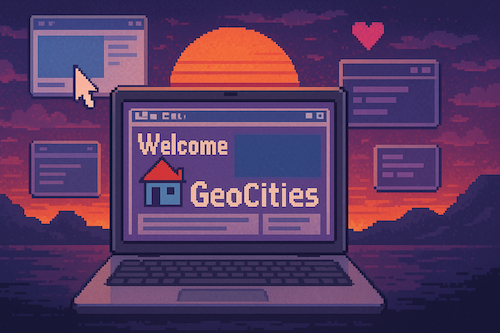
Table of Contents
The internet of 1997… it feels like a different universe now, doesn’t it? Back then, it was a true digital frontier: wild, largely uncharted, and absolutely brimming with a raw, unbridled creativity that’s hard to replicate today. Launching my first homepage on GeoCities wasn’t just about putting up a website; in that nascent era of online self-expression, it felt like planting a flag, a declaration of digital identity.
GeoCities wasn’t merely a web hosting platform; it represented something much more profound. It acted as a powerful democratizing force, transforming people who were primarily passive internet consumers into active digital creators. Remember the structure? Websites weren’t just floating in the ether; they were categorized into thematic “cities”: Hollywood for entertainment, Athens for philosophy and education, Tokyo for Asian culture. This quirky, neighborhood-based system fostered a sense of digital community that was truly unprecedented for its time. You weren’t just building a page; you were joining a virtual neighborhood.
Wrangling Pixels in the Dial-Up Days: The Technical Landscape
Building a homepage back then? It was an adventure requiring a potent mix of sheer curiosity, a willingness to learn basic HTML (often through trial and error, viewing the source of other pages!), and a healthy dose of creative problem-solving. Forget broadband; we were living life at the speed of dial-up. Bandwidth was measured in agonizingly slow kilobits per second, meaning every single kilobyte added to your page (an image, a line of text) was a conscious, strategic decision. Optimization wasn’t a buzzword; it was a survival tactic.
Our special effects? Animated GIFs! Flames, spinning @ signs, ridiculously pixelated figures. These were the height of digital flair. And layouts? Forget clean CSS grids. We wrestled with complex, often invisible, table-based layouts to position elements, a practice that seems incredibly primitive now but was the pinnacle of web design complexity then.
My own GeoCities page enthusiastically embraced the vibrant (some might say garish) aesthetic of the era. It proudly featured:
- Repeating Tiled Backgrounds: Often loud, visually distracting patterns, usually poorly compressed JPEGs or GIFs that tiled endlessly. Seamless they were not.
- Clash-Heavy Color Schemes: Think bright yellow text on a royal blue background, or maybe neon green on purple. Accessibility wasn’t exactly top of mind.
- Mandatory Visitor Counters: A crucial status symbol! Watching that number tick up (even if half the visits were probably you checking your own page) was oddly satisfying.
- Embedded MIDI Music: Ah, the pièce de résistance. An often tinny, synthesized tune that would autoplay the moment someone landed on your page. A feature now almost universally recognized as a cardinal sin of web design, but back then? It was atmosphere!
More Than Hosting: Technological Democratization
What truly made GeoCities revolutionary, though, wasn’t just its free hosting model (supported by banner ads, naturally). It was the underlying philosophy. It took web publishing, previously perceived as a highly technical, almost elite endeavor requiring server knowledge, and made it accessible. Suddenly, anyone with a computer, a modem, and some patience could carve out their own digital space.
Small businesses created their first online brochures, hobbyists shared their passions (model trains, sci-fi, you name it), fan communities coalesced around shared interests; they all found a digital home on GeoCities. It was messy, chaotic, and utterly vibrant. It was the web being built, pixel by pixel, by ordinary people.
Of course, its reign didn’t last forever. The rise of more sophisticated content management systems like WordPress, the advent of blogging platforms, and eventually the explosion of social media offered more structured, dynamic ways to create and connect online. GeoCities eventually faded, acquired by Yahoo! and later shut down (though thankfully archived by efforts like the Internet Archive).
Lasting Echoes: Reflections on Digital Evolution
Yet, studying these early web iterations offers invaluable insights into the arc of digital transformation. GeoCities’ legacy persists. Its core mission, enabling anyone to publish online, lives on in today’s vast ecosystem of platforms like WordPress, Wix, Squarespace, and countless others. Each technological era undeniably builds upon its predecessors; those seemingly primitive solutions of the 90s laid the essential groundwork for the richer, more interactive web we navigate today.
Looking back, my GeoCities experience wasn’t just a quaint personal digital milestone. It was a hands-on lesson in the early stages of a technological revolution, a microcosm of how the internet was fundamentally changing the ways humans communicate, create community, and connect across the globe. It reminds us that even the most sophisticated systems often have humble, slightly awkward beginnings.
What are your memories of the early web? Did you have a GeoCities page? Share your digital nostalgia over on LinkedIn.